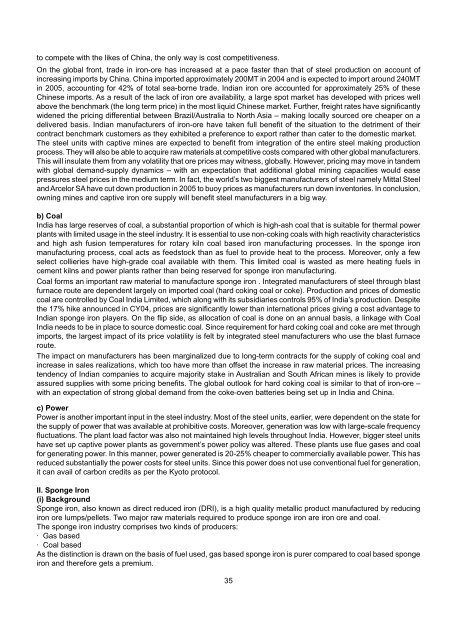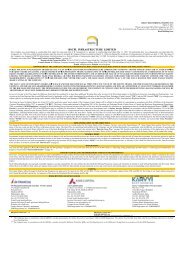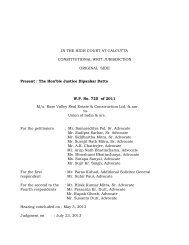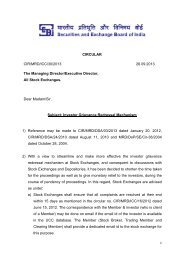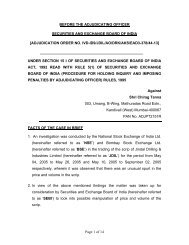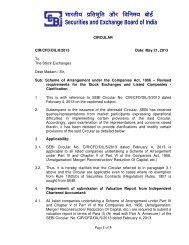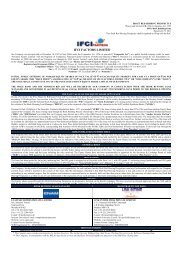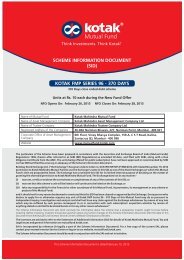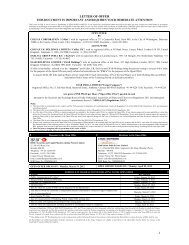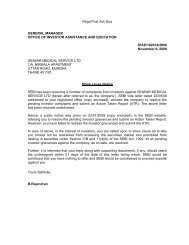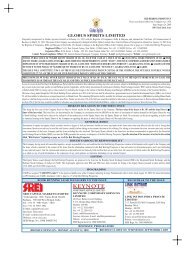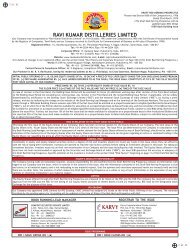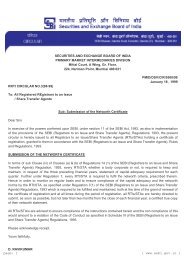KAMDHENU ISPAT LIMITED - Securities and Exchange Board of India
KAMDHENU ISPAT LIMITED - Securities and Exchange Board of India
KAMDHENU ISPAT LIMITED - Securities and Exchange Board of India
You also want an ePaper? Increase the reach of your titles
YUMPU automatically turns print PDFs into web optimized ePapers that Google loves.
to compete with the likes <strong>of</strong> China, the only way is cost competitiveness.<br />
On the global front, trade in iron-ore has increased at a pace faster than that <strong>of</strong> steel production on account <strong>of</strong><br />
increasing imports by China. China imported approximately 200MT in 2004 <strong>and</strong> is expected to import around 240MT<br />
in 2005, accounting for 42% <strong>of</strong> total sea-borne trade. <strong>India</strong>n iron ore accounted for approximately 25% <strong>of</strong> these<br />
Chinese imports. As a result <strong>of</strong> the lack <strong>of</strong> iron ore availability, a large spot market has developed with prices well<br />
above the benchmark (the long term price) in the most liquid Chinese market. Further, freight rates have significantly<br />
widened the pricing differential between Brazil/Australia to North Asia – making locally sourced ore cheaper on a<br />
delivered basis. <strong>India</strong>n manufacturers <strong>of</strong> iron-ore have taken full benefit <strong>of</strong> the situation to the detriment <strong>of</strong> their<br />
contract benchmark customers as they exhibited a preference to export rather than cater to the domestic market.<br />
The steel units with captive mines are expected to benefit from integration <strong>of</strong> the entire steel making production<br />
process. They will also be able to acquire raw materials at competitive costs compared with other global manufacturers.<br />
This will insulate them from any volatility that ore prices may witness, globally. However, pricing may move in t<strong>and</strong>em<br />
with global dem<strong>and</strong>-supply dynamics – with an expectation that additional global mining capacities would ease<br />
pressures steel prices in the medium term. In fact, the world’s two biggest manufacturers <strong>of</strong> steel namely Mittal Steel<br />
<strong>and</strong> Arcelor SA have cut down production in 2005 to buoy prices as manufacturers run down inventories. In conclusion,<br />
owning mines <strong>and</strong> captive iron ore supply will benefit steel manufacturers in a big way.<br />
b) Coal<br />
<strong>India</strong> has large reserves <strong>of</strong> coal, a substantial proportion <strong>of</strong> which is high-ash coal that is suitable for thermal power<br />
plants with limited usage in the steel industry. It is essential to use non-coking coals with high reactivity characteristics<br />
<strong>and</strong> high ash fusion temperatures for rotary kiln coal based iron manufacturing processes. In the sponge iron<br />
manufacturing process, coal acts as feedstock than as fuel to provide heat to the process. Moreover, only a few<br />
select collieries have high-grade coal available with them. This limited coal is wasted as mere heating fuels in<br />
cement kilns <strong>and</strong> power plants rather than being reserved for sponge iron manufacturing.<br />
Coal forms an important raw material to manufacture sponge iron . Integrated manufacturers <strong>of</strong> steel through blast<br />
furnace route are dependent largely on imported coal (hard coking coal or coke). Production <strong>and</strong> prices <strong>of</strong> domestic<br />
coal are controlled by Coal <strong>India</strong> Limited, which along with its subsidiaries controls 95% <strong>of</strong> <strong>India</strong>’s production. Despite<br />
the 17% hike announced in CY04, prices are significantly lower than international prices giving a cost advantage to<br />
<strong>India</strong>n sponge iron players. On the flip side, as allocation <strong>of</strong> coal is done on an annual basis, a linkage with Coal<br />
<strong>India</strong> needs to be in place to source domestic coal. Since requirement for hard coking coal <strong>and</strong> coke are met through<br />
imports, the largest impact <strong>of</strong> its price volatility is felt by integrated steel manufacturers who use the blast furnace<br />
route.<br />
The impact on manufacturers has been marginalized due to long-term contracts for the supply <strong>of</strong> coking coal <strong>and</strong><br />
increase in sales realizations, which too have more than <strong>of</strong>fset the increase in raw material prices. The increasing<br />
tendency <strong>of</strong> <strong>India</strong>n companies to acquire majority stake in Australian <strong>and</strong> South African mines is likely to provide<br />
assured supplies with some pricing benefits. The global outlook for hard coking coal is similar to that <strong>of</strong> iron-ore –<br />
with an expectation <strong>of</strong> strong global dem<strong>and</strong> from the coke-oven batteries being set up in <strong>India</strong> <strong>and</strong> China.<br />
c) Power<br />
Power is another important input in the steel industry. Most <strong>of</strong> the steel units, earlier, were dependent on the state for<br />
the supply <strong>of</strong> power that was available at prohibitive costs. Moreover, generation was low with large-scale frequency<br />
fluctuations. The plant load factor was also not maintained high levels throughout <strong>India</strong>. However, bigger steel units<br />
have set up captive power plants as government’s power policy was altered. These plants use flue gases <strong>and</strong> coal<br />
for generating power. In this manner, power generated is 20-25% cheaper to commercially available power. This has<br />
reduced substantially the power costs for steel units. Since this power does not use conventional fuel for generation,<br />
it can avail <strong>of</strong> carbon credits as per the Kyoto protocol.<br />
II. Sponge Iron<br />
(i) Background<br />
Sponge iron, also known as direct reduced iron (DRI), is a high quality metallic product manufactured by reducing<br />
iron ore lumps/pellets. Two major raw materials required to produce sponge iron are iron ore <strong>and</strong> coal.<br />
The sponge iron industry comprises two kinds <strong>of</strong> producers:<br />
· Gas based<br />
· Coal based<br />
As the distinction is drawn on the basis <strong>of</strong> fuel used, gas based sponge iron is purer compared to coal based sponge<br />
iron <strong>and</strong> therefore gets a premium.<br />
35


